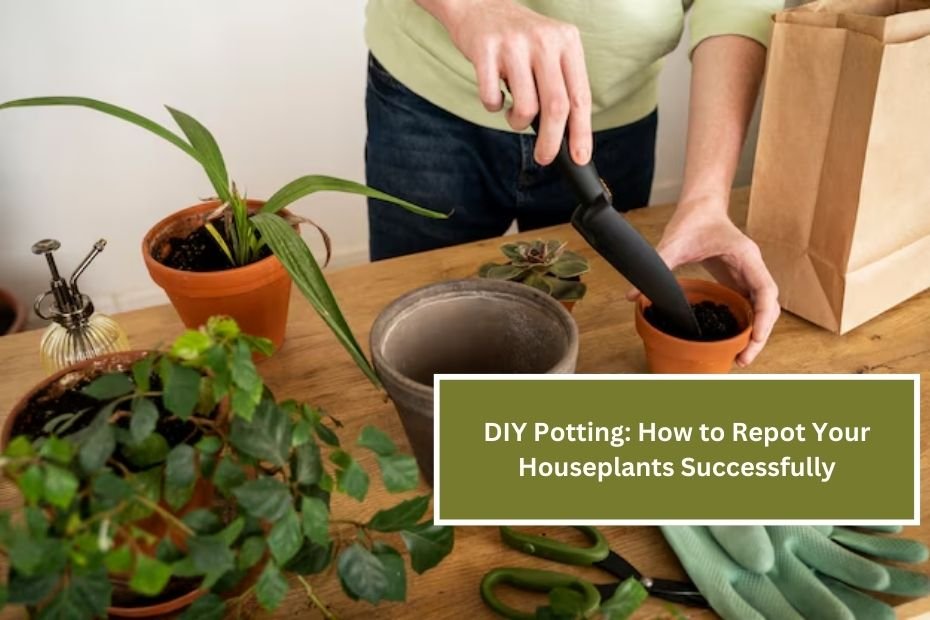Repotting houseplants is an essential part of plant care. It helps keep your plants healthy and thriving by providing them with fresh soil, more space for growth, and an opportunity to check on their roots. In this article, we’ll walk you through the process of repotting your houseplants, discuss when to repot, and share some tips for success. Let’s dive in!
Why Repot Your Houseplants?
Repotting can seem like a daunting task, but it’s beneficial for your plants in several ways:
- Fresh Soil: Over time, the nutrients in the soil get depleted. By repotting, you give your plants fresh nutrients to grow.
- More Space: As plants grow, they may outgrow their pots. A larger pot allows roots to expand and absorb more nutrients and water.
- Root Health: Repotting lets you inspect the roots for signs of rot or disease, allowing for early intervention.
- Improved Drainage: Old soil can become compacted, leading to poor drainage. Fresh soil helps prevent water from pooling at the bottom of the pot.
When to Repot Your Houseplants
Knowing when to repot is crucial for your plant’s health. Here are some signs that it’s time to repot:
- Roots are Growing Out of the Drainage Holes: If you see roots peeking out from the bottom of the pot, your plant needs more space.
- Soil Dries Out Too Quickly: If the soil seems to dry out within a day or two of watering, it may be time for a new pot with fresh soil.
- Water Sits on Top of the Soil: If water isn’t soaking in and is sitting on top, the soil may be too compacted, indicating a need for repotting.
- Plant Looks Stunted or Unhealthy: If your plant isn’t growing well or looks unhealthy despite proper care, it might be root-bound and need repotting.
How to Repot Your Houseplants
Now that you know why and when to repot, let’s go through the steps of repotting your houseplants successfully.
Step 1: Gather Your Supplies
Before you start, gather the necessary materials:
- New Pot: Choose a pot that is one size larger than the current one. Ensure it has drainage holes.
- Fresh Potting Soil: Use a high-quality potting mix suitable for your specific plant type (cactus mix, orchid mix, etc.).
- Trowel or Scoop: For transferring soil and working with roots.
- Watering Can: To water the plant after repotting.
- Gloves: Optional, but they can protect your hands.
- Plastic Sheet or Newspaper: To protect your workspace from soil spills.
Step 2: Prepare the New Pot
Before you begin, prepare the new pot:
- Place a layer of fresh potting soil at the bottom of the new pot. This will create a cushion for the roots and ensure good drainage.
Step 3: Remove the Plant from Its Current Pot
Now it’s time to take the plant out of its current pot:
- Water the Plant: A day or two before repotting, water your plant thoroughly. This makes it easier to remove from the pot.
- Turn the Pot Upside Down: Gently hold the base of the plant and turn the pot upside down. Tap the bottom of the pot to loosen the soil.
- Gently Pull the Plant Out: If the plant doesn’t come out easily, try gently squeezing the sides of the pot to loosen the root ball. Be careful not to damage the roots.
Step 4: Inspect the Roots
Once you have removed the plant from its pot, take a moment to inspect the roots:
- Healthy Roots: Look for white or light tan roots that are firm and healthy.
- Rotten Roots: If you see mushy, brown, or black roots, these are signs of root rot. Trim away the damaged roots with clean, sharp scissors.
- Root Bound: If the roots are tightly bound in a circular shape, gently tease them apart to encourage new growth.
Step 5: Place the Plant in the New Pot
Now it’s time to place the plant in its new home:
- Position the Plant: Place the plant in the center of the new pot, ensuring it sits at the same depth as it did in the old pot. The top of the root ball should be about an inch below the rim of the pot.
- Add Soil: Fill in around the root ball with fresh potting soil. Use your fingers or a trowel to gently pack the soil, ensuring there are no air pockets.
- Leave Space for Water: Make sure to leave about an inch of space from the top of the soil to the rim of the pot for watering.
Step 6: Water the Plant
After repotting, give your plant a good drink:
- Water the plant thoroughly, allowing water to drain from the bottom of the pot. This helps settle the soil and ensures the roots have enough moisture.
- Be careful not to overwater; the soil should be damp but not soggy.
Step 7: Care for Your Repotted Plant
Once your plant is repotted, it will need some special care:
- Choose a Suitable Location: Place your plant in a location with appropriate light levels, considering the type of plant.
- Monitor Watering: Check the soil moisture regularly. It may need less water for a few weeks as it adjusts to its new pot.
- Avoid Fertilizing Immediately: Wait a month or so before fertilizing. The fresh soil will have enough nutrients to support your plant during this adjustment period.
Tips for Successful Repotting
Here are some additional tips to ensure a successful repotting experience:
- Repot in the Spring: The best time to repot most houseplants is in the spring when they are actively growing.
- Choose the Right Soil: Use a potting mix appropriate for your plant species. Cacti and succulents, for example, require well-draining soil, while tropical plants may prefer a richer mix.
- Be Gentle: Handle the roots carefully to avoid damage. If you must prune, use clean tools to prevent infection.
- Don’t Overpot: Choose a pot that is only one size larger. If the pot is too big, the soil may retain too much moisture, leading to root rot.
Conclusion
Repotting your houseplants is a vital process that promotes healthy growth and overall well-being. By understanding the signs that indicate it’s time to repot and following the steps outlined above, you can ensure that your plants thrive in their new environment. Remember to choose the right pot, fresh soil, and take good care of your plants after repotting. With a little patience and care, your houseplants will flourish, bringing beauty and freshness into your home.

